Trematode lifecycle stages
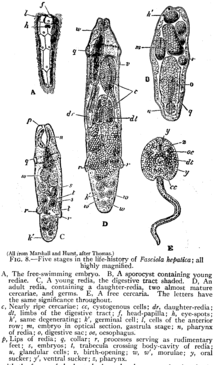
Trematodes are small parasitic flatworms that use vertebrates as their definitive host, and molluscs (usually freshwater snails or land snails) as their intermediate host. In order to accomplish this, they have several varied life cycle stages.
The life cycle of a typical digenean trematode can be thought to begin when its egg is immersed in water. Following this a miracidium hatches, which swims to find a mollusc host. The miracidia go through several stages in the mollusc host, eventually emerging as motile cercaria larvae.[1] The cercaria either infect vertebrates through the skin or are ingested. In its vertebrate host, the cercaria matures to an adult form, and lays eggs that are discharged with the host faeces or urine. In the presence of open water, the eggs will hatch and the miracidium stage of life is reached again.
Typical lifecyle stages

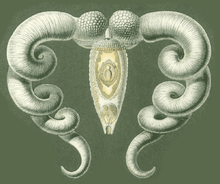
While the details vary with each species, the general lifecycle stages are as follows:
- Egg – discharged either in open water or in intestine of definitive host.
- Miracidium (plural Miracidia) – free-living motile form, covered with cilia, which settles in the mollusc to become a sporocyst.[3]
- Sporocyst – an elongated sac that produces either rediae or more sporocysts.[4]
- Redia (plural rediae) – a larval form with an oral sucker, it will produce either more rediae, or cercariae.[4]
- Cercaria (plural cercariae) – the larval form of the parasite, developed within the germinal cells of the sporocyst or redia.[4] A cercaria has a tapering head with large penetration glands.[3] It may or may not have a long swimming "tail", depending on the species.[4] The motile cercaria finds and settles in a host where it will become either an adult, or a mesocercaria, or a metacercaria, according to species.
- Mesocercaria – a cercaria little modified but resting.
- Metacercaria – a cercaria encysted and resting.
- Adult – the fully developed mature stage, capable of sexual reproduction.
Deviations from the typical lifecycle
Not all trematodes follow the typical sequence of eggs, miracidia, sporocysts, rediae, cercariae, and adults. In some species the redia stage is omitted, and sporocysts produce cercariae. In some species, the cercaria develops into an adult within the same host.
Many digenean trematodes require two hosts, one (typically a snail) where asexual reproduction occurs in sporocysts, the other a vertebrate (typically a fish) where the adult form engages in sexual reproduction to produce eggs. In some species (for example Ribeiroia) the cercaria encysts, and waits until the host is eaten by a third host, in whose gut it emerges and develops into an adult.
Most trematodes are hermaphroditic, but members of the family Schistosomatidae are dioecious. Males are shorter and stouter than the females.[3]
Representations of lifecycles of several different trematode species
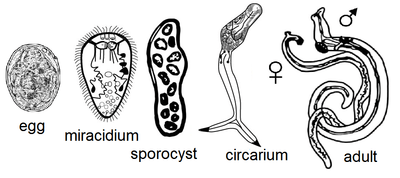
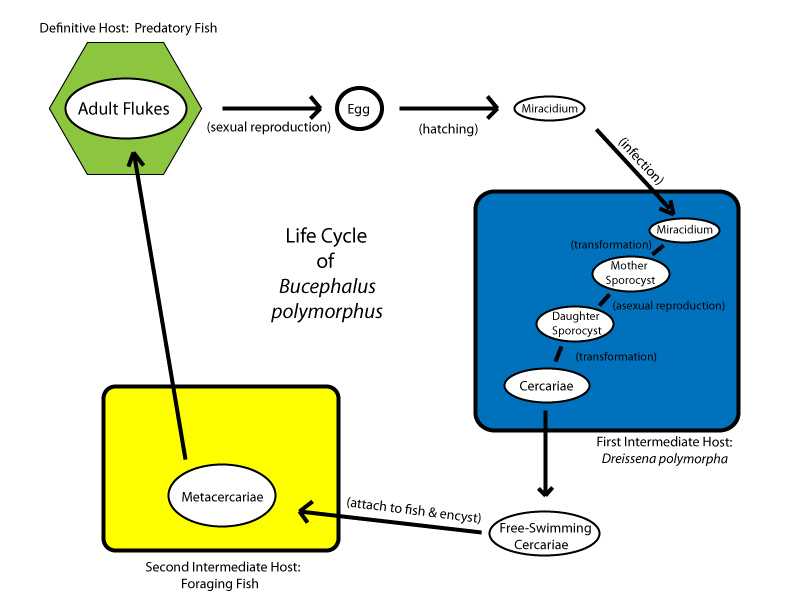
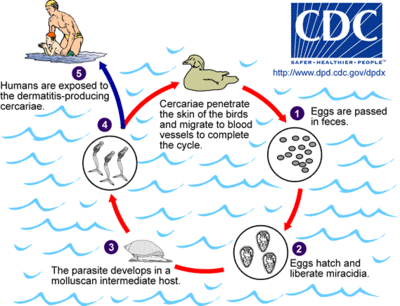
References
- ↑ "2. FISH DISEASES (Contd.) 2.1.4 Parasitic Diseases". FAO of the UN Food and Agriculture Organization of the United Nations. Retrieved 18 February 2011.
- ↑ Caffara, M., Davidovich, N., Falk, R., Smirnov, M., Ofek, T., Cummings, D., Gustinelli, A. & Fioravanti, M. L. 2014: Redescription of Clinostomum phalacrocoracis metacercariae (Digenea: Clinostomidae) in cichlids from Lake Kinneret, Israel. Parasite, 21, 32. doi:10.1051/parasite/2014034 PubMed PMC 4078730
- ↑ 3.0 3.1 3.2 "Schistosoma". Australian Society for Parasitology. Retrieved 19 February 2011.
- ↑ 4.0 4.1 4.2 4.3 "Glossary". VPTH 603 Veterinary Parasitology. University of Pennsylvania School of Veterinary Medicine.
See also
- Bucephalus polymorphus
- Trematode infection
- Apicomplexa lifecycle stages